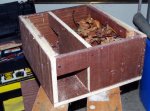Actually, I like fuzzy little creatures.
So, I'm thinking that it is probably better to just go with the old ways and provide the space for them to hibernate and next year see if you have more of the little spiked critters.
I'm sure everyone knew you were only kidding.
Hogs are very much in focus in the UK at the moment. Unfortunately, this is because of their rapid decline in numbers. It is believed that there are only one million of them left. Although not yet on the official endangered list, I doubt it will be long before they are. In the sixties and seventies, almost every domestic household with a garden shed had a hog living under it. More recently, hardly any households have seen one. We have done several presentations at local schools and hardly any of the kids have ever seen one, which is really rather sad.
We loan out footprint tunnels and trail cameras to interested parties to see if they have any hog (or other) activity in their gardens. It was amazing how much uptake there was on this and we still have a waiting list.
Hibernation box occupancy is not as simple as it sounds which is why my current endeavours are based around RFID but even if your hogs have been chipped (obviously, only those that have visited the vet are) it is still far from job done. Just putting a scanner on the side of the box does not work. The hog must actually pass through the coil. I've been in contact with a RFID manufacturer and they have produced an "extra sensitive" version but even that struggles to get through the layers of a damp nest to the chip inside the hog. (and yes, it is driven by a PICAXE for the ID decode and data logging with "send text on activity" soon to be added.)
Meanwhile, keep the ideas coming. This is of national interest, not just us guys! Experts up and down the country have been asking the very same question.

